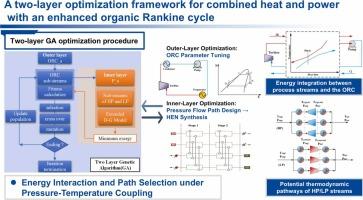A two-layer optimization framework for combined heat and power with an enhanced organic rankine cycle
IF 3.9
3区 工程技术
Q2 ENGINEERING, CHEMICAL
引用次数: 0
Abstract
Integration of Organic Rankine Cycle (ORC) and chemical process is conductive to raise energy efficiency and mitigate carbon emissions. Current studies chiefly consider combination of ORC and heat exchanger network to recover low-temperature waste heat, which neglects power-heat interaction for process streams with pressure and temperature variations. To address this issue, this paper proposes a two-layer optimization framework to achieve the integration of an enhanced ORC and process streams with pressure/temperature variation. The presented framework aims to optimize the pressure-temperature path of process streams through the network for optimal combined heat and power generation. The outer layer focuses on optimizing the configurations and operating parameters of the ORC, while the inner layer utilizes an extended Duran-Grossmann model (D-G model) to reduce utility consumption by determining the optimal inlet temperature of the pressure-change sub-streams. The objective function is to minimize the exergy consumption. Case studies with six schemes are performed to assess the effectiveness of the presented method, where the amount of total heat recovery increased by 82.7 % compared to the approach without using ORC. The main contributions of the proposed framework are of significant aid in providing guidelines for the further development of low-temperature waste heat recovery combined with a power/heat-integrated system.

基于强化有机朗肯循环的热电联产两层优化框架
有机朗肯循环(ORC)与化学过程的整合有助于提高能源效率和减少碳排放。目前的研究主要考虑ORC与热交换器网络的组合来回收低温余热,忽略了压力和温度变化过程流的功率-热相互作用。为了解决这一问题,本文提出了一个两层优化框架,以实现增强的ORC和具有压力/温度变化的工艺流的集成。提出的框架旨在通过网络优化工艺流的压力-温度路径,以实现最优的热电联产。外层侧重于优化ORC的配置和运行参数,而内层采用扩展的杜兰-格罗斯曼模型(D-G模型),通过确定压力变化子流的最佳入口温度来降低效用消耗。目标函数是使能耗最小化。采用六种方案进行了案例研究,以评估所提出方法的有效性,其中总热回收率与不使用ORC的方法相比增加了82.7 %。所提出的框架的主要贡献是为低温废热回收结合动力/热集成系统的进一步发展提供指导方针。
本文章由计算机程序翻译,如有差异,请以英文原文为准。
求助全文
约1分钟内获得全文
求助全文
来源期刊

Chemical Engineering Research & Design
工程技术-工程:化工
CiteScore
6.10
自引率
7.70%
发文量
623
审稿时长
42 days
期刊介绍:
ChERD aims to be the principal international journal for publication of high quality, original papers in chemical engineering.
Papers showing how research results can be used in chemical engineering design, and accounts of experimental or theoretical research work bringing new perspectives to established principles, highlighting unsolved problems or indicating directions for future research, are particularly welcome. Contributions that deal with new developments in plant or processes and that can be given quantitative expression are encouraged. The journal is especially interested in papers that extend the boundaries of traditional chemical engineering.
 求助内容:
求助内容: 应助结果提醒方式:
应助结果提醒方式:


